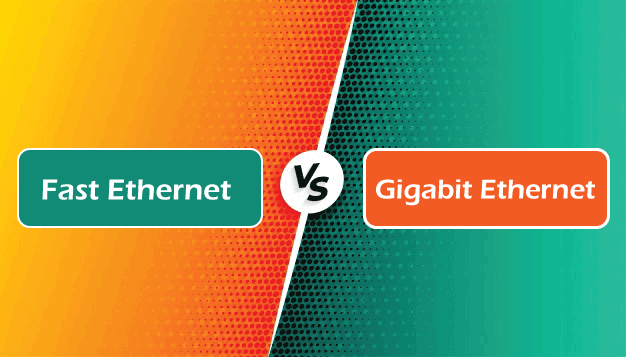Key Differences between Fast Ethernet and Gigabit Ethernet

Fast Ethernet and Gigabit Ethernet are both networking technologies used to transmit data over Ethernet networks, but they differ in terms of their speed, performance, and capabilities. Here are the key differences between Fast Ethernet and Gigabit Ethernet:
-
Speed:
- Fast Ethernet: Fast Ethernet supports data transmission speeds of up to 100 megabits per second (Mbps), which is ten times faster than traditional Ethernet (10 Mbps).
- Gigabit Ethernet: Gigabit Ethernet supports data transmission speeds of up to 1 gigabit per second (Gbps), which is ten times faster than Fast Ethernet and one hundred times faster than traditional Ethernet.
-
Bandwidth:
- Fast Ethernet: Fast Ethernet provides a maximum bandwidth of 100 Mbps.
- Gigabit Ethernet: Gigabit Ethernet provides a maximum bandwidth of 1 Gbps, offering significantly higher throughput and bandwidth compared to Fast Ethernet.
-
Backward Compatibility:
- Both Fast Ethernet and Gigabit Ethernet are backward compatible with traditional Ethernet (10 Mbps). This means that existing Ethernet infrastructure and devices can coexist with Fast Ethernet and Gigabit Ethernet equipment, allowing for a gradual network upgrade.
-
Duplexing Options:
- Both Fast Ethernet and Gigabit Ethernet support both half-duplex and full-duplex communication modes. Full-duplex operation allows for simultaneous two-way communication between devices, enhancing network efficiency.
-
Media Types:
- Both Fast Ethernet and Gigabit Ethernet support various types of physical media, including twisted-pair copper cables (e.g., Category 5e or Category 6) and fiber optic cables. Different media types offer flexibility in choosing the most suitable medium for specific network requirements.
-
Cost:
- Gigabit Ethernet infrastructure, including switches, routers, network interface cards, and cabling, can be more expensive compared to Fast Ethernet. The cost of upgrading to Gigabit Ethernet should be considered, especially for organizations with budget constraints.
-
Applications:
- Gigabit Ethernet is well-suited for scenarios requiring high-speed connectivity and bandwidth, such as enterprise LANs, campus networks, and data center environments. Fast Ethernet, while still widely used, may be limited in meeting the demands of modern applications and data-intensive tasks.
-
Scalability:
- Gigabit Ethernet provides scalability to accommodate the increasing number of connected devices and the growing demand for network bandwidth. This scalability is essential for organizations experiencing network expansion and growth.
In summary, Gigabit Ethernet offers significantly higher data transmission speeds and bandwidth compared to Fast Ethernet, making it suitable for modern networking applications that require high-speed connectivity and efficient data transfer. However, the choice between Fast Ethernet and Gigabit Ethernet depends on factors such as budget, network requirements, and the need for higher performance.
Thank you,
